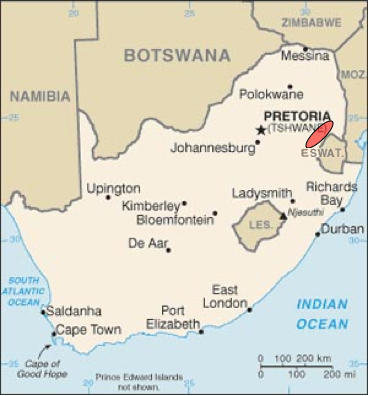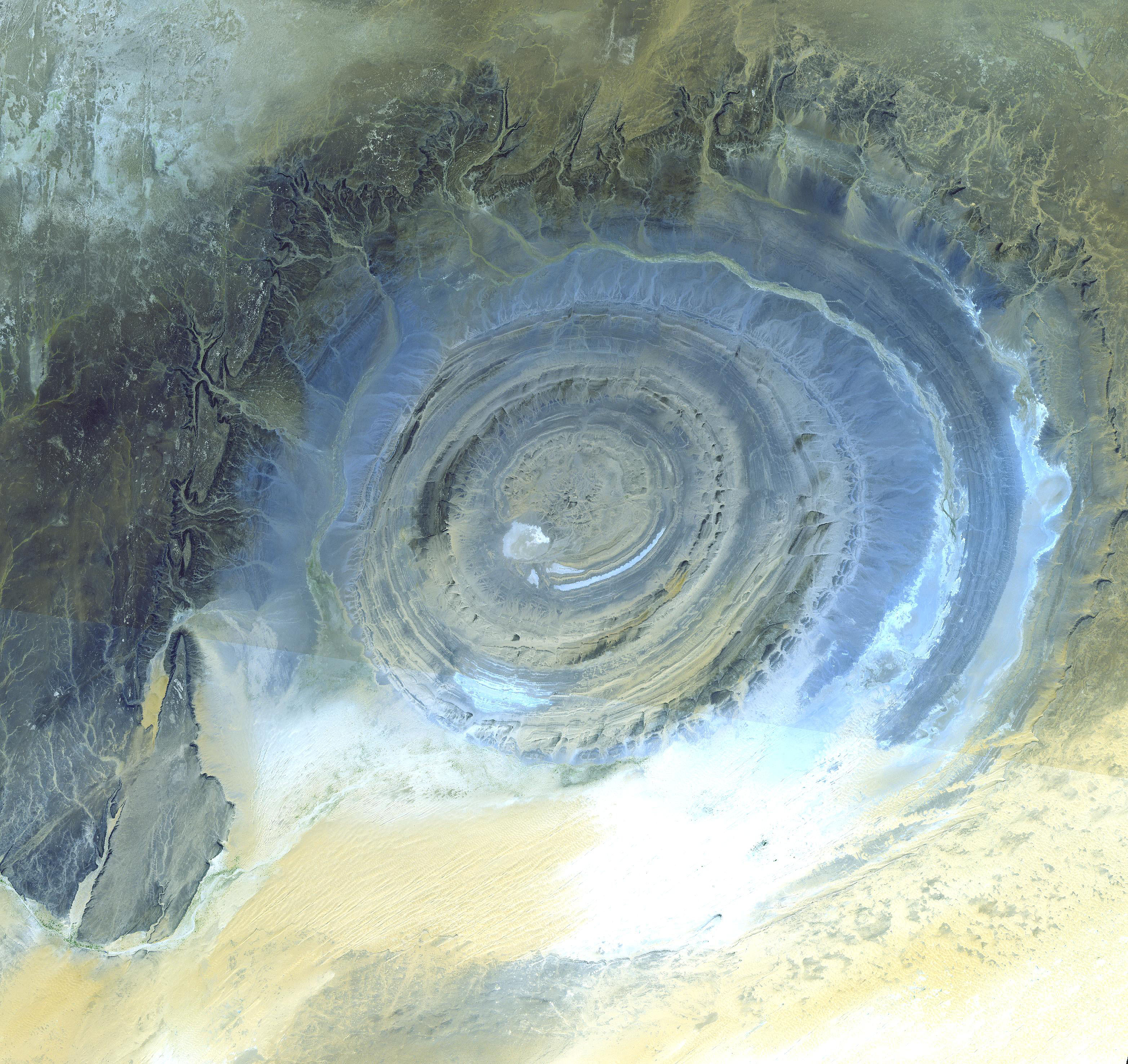|
Tectonic Evolution Of The Barberton Greenstone Belt
The Barberton greenstone belt (BGB) is located in the Kapvaal craton of southeastern Africa. It characterizes one of the most well-preserved and oldest pieces of continental crust today by containing rocks in the Barberton Granite Greenstone Terrain (3.55–3.22 Gigaannum, Ga). The BGB is a small, cusp-shaped succession of volcanic and sedimentary rocks, surrounded on all sides by granitoid plutons which range in age from >3547 to 3547 to ~3260 Ma and is over 10 km thick. The Fig Tree Group was deposited between ~3260 and 3225 Ma. It is defined as a transitional unit of interlayered volcanic clasts and land derived sediments that were eroded from the underlying greenstone succession. The Moodies Group, post-3225 Ma, is a combination of sandstone and Conglomerate (geology), conglomerate originating from the erosion of the underlying greenstone unit and the uplifted plutonic rocks. Structure The structural pattern within the region shows a series of anticli ... [...More Info...] [...Related Items...] OR: [Wikipedia] [Google] [Baidu] |
Barberton Greenstone Belt
The Barberton Greenstone Belt is situated on the eastern edge of Kaapvaal Craton in South Africa. It is known for its gold mineralisation and for its komatiites, an unusual type of ultramafic volcanic rock named after the Komati River that flows through the belt. Some of the oldest exposed rocks on Earth (greater than 3.6 Ga) are located in the Barberton Greenstone Belt of the Eswatini–Barberton areas and these contain some of the oldest traces of life on Earth, second only to the Isua Greenstone Belt of Western Greenland. The Makhonjwa Mountains make up 40% of the Baberton belt. History and description In April 2014, scientists reported finding evidence of the largest terrestrial meteor impact event to date near the Barberton Greenstone Belt. They estimated the impact occurred about 3.26 billion years ago (during the Paleoarchean era of the Archean eon of the Precambrian supereon) and that the impactor was approximately wide, roughly five times larger than the impactor re ... [...More Info...] [...Related Items...] OR: [Wikipedia] [Google] [Baidu] |
Island Arcs
Island arcs are long chains of active volcanoes with intense seismic activity found along convergent tectonic plate boundaries. Most island arcs originate on oceanic crust and have resulted from the descent of the lithosphere into the mantle along the subduction zone. They are the principal way by which continental growth is achieved. Island arcs can either be active or inactive based on their seismicity and presence of volcanoes. Active arcs are ridges of recent volcanoes with an associated deep seismic zone. They also possess a distinct curved form, a chain of active or recently extinct volcanoes, a deep-sea trench, and a large negative Bouguer anomaly on the convex side of the volcanic arc. The small positive gravity anomaly associated with volcanic arcs has been interpreted by many authors as due to the presence of dense volcanic rocks beneath the arc. Inactive arcs are a chain of islands which contains older volcanic and volcaniclastic rocks. The curved shape of many vo ... [...More Info...] [...Related Items...] OR: [Wikipedia] [Google] [Baidu] |
Granite
Granite () is a coarse-grained (phaneritic) intrusive igneous rock composed mostly of quartz, alkali feldspar, and plagioclase. It forms from magma with a high content of silica and alkali metal oxides that slowly cools and solidifies underground. It is common in the continental crust of Earth, where it is found in igneous intrusions. These range in size from dikes only a few centimeters across to batholiths exposed over hundreds of square kilometers. Granite is typical of a larger family of ''granitic rocks'', or ''granitoids'', that are composed mostly of coarse-grained quartz and feldspars in varying proportions. These rocks are classified by the relative percentages of quartz, alkali feldspar, and plagioclase (the QAPF classification), with true granite representing granitic rocks rich in quartz and alkali feldspar. Most granitic rocks also contain mica or amphibole minerals, though a few (known as leucogranites) contain almost no dark minerals. Granite is nearly alway ... [...More Info...] [...Related Items...] OR: [Wikipedia] [Google] [Baidu] |
Minerals
In geology and mineralogy, a mineral or mineral species is, broadly speaking, a solid chemical compound with a fairly well-defined chemical composition and a specific crystal structure that occurs naturally in pure form.John P. Rafferty, ed. (2011): Minerals'; p. 1. In the series ''Geology: Landforms, Minerals, and Rocks''. Rosen Publishing Group. The geological definition of mineral normally excludes compounds that occur only in living organisms. However, some minerals are often biogenic (such as calcite) or are organic compounds in the sense of chemistry (such as mellite). Moreover, living organisms often synthesize inorganic minerals (such as hydroxylapatite) that also occur in rocks. The concept of mineral is distinct from rock, which is any bulk solid geologic material that is relatively homogeneous at a large enough scale. A rock may consist of one type of mineral, or may be an aggregate of two or more different types of minerals, spacially segregated into distinct ... [...More Info...] [...Related Items...] OR: [Wikipedia] [Google] [Baidu] |
Feldspar
Feldspars are a group of rock-forming aluminium tectosilicate minerals, also containing other cations such as sodium, calcium, potassium, or barium. The most common members of the feldspar group are the ''plagioclase'' (sodium-calcium) feldspars and the ''alkali'' (potassium-sodium) feldspars. Feldspars make up about 60% of the Earth's crust, and 41% of the Earth's continental crust by weight. Feldspars crystalize from magma as both intrusive and extrusive igneous rocks and are also present in many types of metamorphic rock. Rock formed almost entirely of calcic plagioclase feldspar is known as anorthosite. Feldspars are also found in many types of sedimentary rocks. Compositions The feldspar group of minerals consists of tectosilicates, silicate minerals in which silicon ions are linked by shared oxygen ions to form a three-dimensional network. Compositions of major elements in common feldspars can be expressed in terms of three endmembers: * potassium feldspar (K-spar) ... [...More Info...] [...Related Items...] OR: [Wikipedia] [Google] [Baidu] |
Plagioclase
Plagioclase is a series of tectosilicate (framework silicate) minerals within the feldspar group. Rather than referring to a particular mineral with a specific chemical composition, plagioclase is a continuous solid solution series, more properly known as the plagioclase feldspar series. This was first shown by the German mineralogist Johann Friedrich Christian Hessel (1796–1872) in 1826. The series ranges from albite to anorthite endmembers (with respective compositions NaAlSi3O8 to CaAl2Si2O8), where sodium and calcium atoms can substitute for each other in the mineral's crystal lattice structure. Plagioclase in hand samples is often identified by its polysynthetic crystal twinning or 'record-groove' effect. Plagioclase is a major constituent mineral in the Earth's crust, and is consequently an important diagnostic tool in petrology for identifying the composition, origin and evolution of igneous rocks. Plagioclase is also a major constituent of rock in the highlan ... [...More Info...] [...Related Items...] OR: [Wikipedia] [Google] [Baidu] |
Dome (geology)
A dome is a feature in structural geology consisting of symmetrical anticlines that intersect each other at their respective apices. Intact, domes are distinct, rounded, spherical-to- ellipsoidal-shaped protrusions on the Earth's surface. However, a transect parallel to Earth's surface of a dome features concentric rings of strata. Consequently, if the top of a dome has been eroded flat, the resulting structure in plan view appears as a bullseye, with the youngest rock layers at the outside, and each ring growing progressively older moving inwards. These strata would have been horizontal at the time of deposition, then later deformed by the uplift associated with dome formation. Formation mechanisms There are many possible mechanisms responsible for the formation of domes, the foremost of which are post-impact uplift, refolding, and diapirism. Post-impact uplift A complex crater, caused by collision of a hypervelocity body with another larger than itself, is typified by th ... [...More Info...] [...Related Items...] OR: [Wikipedia] [Google] [Baidu] |
Intrusive Rock
Intrusive rock is formed when magma penetrates existing rock, crystallizes, and solidifies underground to form ''Igneous intrusion, intrusions'', such as batholiths, dike (geology), dikes, Sill (geology), sills, laccoliths, and volcanic necks.Intrusive RocksIntrusive rocks accessdate: March 27, 2017.Igneous intrusive rocks, accessdate: March 27, 2017.Britannica.comintrusive rock , geology , Britannica.com accessdate: March 27, 2017. Intrusion is one of the two ways igneous rock can form. The other is extrusive rock, extrusion, such as a Types of volcanic eruptions, volcanic eruption or similar event. An intrusion is any body of intrusive igneous rock, formed from magma that cools and solidifies within the crust of the planet. In contrast, an ''extrusion'' consists of extrusive rock, formed above the surface of the crust. Some geologists use the term plutonic rock synonymously with intrusive rock, but other geologists subdivide intrusive rock, by crystal size, into coarse-grai ... [...More Info...] [...Related Items...] OR: [Wikipedia] [Google] [Baidu] |
Sedimentary
Sedimentary rocks are types of rock (geology), rock that are formed by the accumulation or deposition of mineral or organic matter, organic particles at Earth#Surface, Earth's surface, followed by cementation (geology), cementation. Sedimentation is the collective name for processes that cause these particles to settle in place. The particles that form a sedimentary rock are called sediment, and may be composed of detritus (geology), geological detritus (minerals) or detritus, biological detritus (organic matter). The geological detritus originated from weathering and erosion of existing rocks, or from the solidification of molten lava blobs erupted by volcanoes. The geological detritus is transported to the place of deposition by water, wind, ice or Mass wasting, mass movement, which are called agents of denudation. Biological detritus was formed by bodies and parts (mainly shells) of dead aquatic organisms, as well as their fecal mass, suspended in water and slowly piling up on ... [...More Info...] [...Related Items...] OR: [Wikipedia] [Google] [Baidu] |
Supracrustal
Supracrustal rocks (''supra'' (Latin for "above")) are rocks that were deposited on the existing basement rocks of the crust, hence the name. They may be further metamorphosed from both sedimentary and volcanic rocks. The oldest minerals on Earth are detrital zircon grains from the Yilgarn Craton in the Mesoarchaean (3.2–2.8 Ga) Jack Hills, Western Australia dated to up to 4.4 Ga, meaning that granitic continental crust and probably supracrustal rocks formed during the Hadean, within 200 million years of Earth accretion. Most Hadean rocks were probably recycled into the mantle before the end of the eon, however, and such pre-4.0 Ga mineral inclusions, the only traces from the earliest rock formation on Earth, are rare. The Acasta orthogneisses of the Slave Craton, Canada, are regarded to be the oldest rocks on Earth, dated to 4.06 Ga, include protoliths such as TTGs, amphibolite, gabbro, granite, and diorite. It is possible that such early Hadean TTGs w ... [...More Info...] [...Related Items...] OR: [Wikipedia] [Google] [Baidu] |
South African Greenstone Belt
South is one of the cardinal directions or compass points. The direction is the opposite of north and is perpendicular to both east and west. Etymology The word ''south'' comes from Old English ''sūþ'', from earlier Proto-Germanic ''*sunþaz'' ("south"), possibly related to the same Proto-Indo-European root that the word ''sun'' derived from. Some languages describe south in the same way, from the fact that it is the direction of the sun at noon (in the Northern Hemisphere), like Latin meridies 'noon, south' (from medius 'middle' + dies 'day', cf English meridional), while others describe south as the right-hand side of the rising sun, like Biblical Hebrew תֵּימָן teiman 'south' from יָמִין yamin 'right', Aramaic תַּימנַא taymna from יָמִין yamin 'right' and Syriac ܬܰܝܡܢܳܐ taymna from ܝܰܡܝܺܢܳܐ yamina (hence the name of Yemen, the land to the south/right of the Levant). Navigation By convention, the ''bottom or down-facing side'' of a ... [...More Info...] [...Related Items...] OR: [Wikipedia] [Google] [Baidu] |





